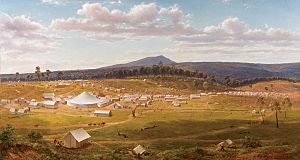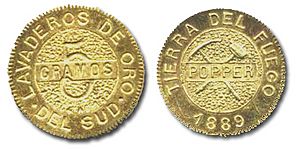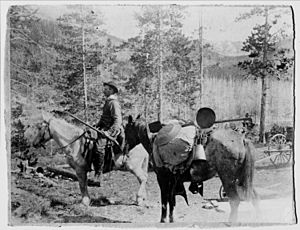Gold rush facts for kids
A gold rush happens when many people quickly move to a place where gold has been found. They hope to find their own fortune! Famous examples include the California Gold Rush in 1849 and the Klondike Gold Rush in the 1890s. Australia also had a big gold rush starting in 1851.
Most miners, called "diggers," didn't get rich from gold mining. But some people did make huge fortunes. Gold rushes caused many people to move to new areas. This often led to new towns and permanent settlements. These events greatly shaped the culture of places like Australia and North America. Back then, the world's money was based on gold. So, new gold discoveries boosted economies far beyond the mining areas.
Gold rushes have happened for a very long time. Even in Ancient Greece, people mined for gold. Writers like Diodarus Sicules and Pliny the Elder described these early gold mining activities. Gold rushes were also a popular topic for TV shows and books. For example, the book The Call of the Wild was very successful during that time.
Contents
How a Gold Rush Unfolds


A gold rush usually starts when someone discovers "placer gold." This is gold found in sand or gravel, often in riverbeds. At first, individual miners might wash the gold using a simple gold pan. This takes a lot of effort.
If there's a lot of gold-bearing dirt, miners build "rockers" or "sluice boxes." These tools help a small group find gold much faster than with pans. As more gold is found, mining can become a bigger operation. Small mining areas might combine into larger ones. Miners might dig tunnels to reach hard-to-get gold. They might also build dams and canals to bring water to dry areas for washing gold. More advanced methods like hydraulic mining (using powerful water jets) or dredging (using machines to scoop up riverbeds) might be used.
The easy gold in stream beds would eventually run out. Then, miners would look for the original source of the gold. This source is often found in veins of "lode gold" deep underground. As miners dig deeper, they might find gold mixed with other minerals. This gold needs special treatment, like smelting (melting it at high temperatures). If the gold ore is rich enough, it can be sent to a distant smelter. If it's lower quality, it might be treated on-site. Sometimes, mining changes from underground tunnels to large open-pit mining as the gold becomes harder to find.
Gold Rushes Around the World
Australia and New Zealand Discover Gold

Many gold rushes happened in Australia during the second half of the 1800s. The most important ones were in New South Wales and Victoria in 1851. Later, Western Australia had its own rushes in the 1890s. These events were very important for the colonies. They brought many new people, called immigrants, to Australia. Governments spent a lot of money building roads and other things to support these new arrivals. Some people found gold and became rich. Others didn't, but they often stayed and became farmers.
Gold was found in many places, including:
- Ballarat, Victoria
- Bathurst, New South Wales
- Bendigo, Victoria
- Kalgoorlie, Western Australia
In New Zealand, the Central Otago Gold Rush started in 1861. Miners from California and Australia came to try their luck. Many then moved to the West Coast Gold Rush in 1864.
North America's Gold Fever
The first major gold rush in the United States was in Cabarrus County, North Carolina, in 1799. This happened at what is now Reed Gold Mine. Thirty years later, in 1829, the Georgia Gold Rush took place. The most famous one, the California Gold Rush of 1848–55, really captured people's imaginations. This rush led to many Americans settling in California. The state quickly joined the United States in 1850. The California gold rush also made people around the world interested in finding gold. This led to new rushes in Australia, South Africa, and other places.
More gold rushes followed across western North America. These included places in British Columbia, Nevada, Colorado, Idaho, and Montana. Alaska also had its first gold rush in the mid-1890s near Hope, Alaska. Other famous Alaskan rushes were in Nome and Fairbanks.

One of the last "great gold rushes" was the Klondike Gold Rush in Canada's Yukon Territory (1896–99). This rush is famous from books by Jack London and Charlie Chaplin's movie The Gold Rush. The main gold area was near the Klondike River, close to what became Dawson City. This rush also helped open up Alaska for exploration and led to other gold discoveries.
The most successful North American gold rush was the Porcupine Gold Rush in Timmins, Ontario. This rush was different because the gold was deep in the ground, not in rivers. It needed big mining machines. This gold rush was biggest in the 1940s and 1950s, but it's still active today! Over 200 million ounces of gold have been found there, making it one of the largest gold deposits in the world.
Africa's Golden Discoveries
In South Africa, the Witwatersrand Gold Rush was very important. It led to the founding of Johannesburg, a major city. It also caused problems between the Boers (Dutch settlers) and British settlers, as well as Chinese miners.
South Africa's gold production grew very fast. From nothing in 1886, it became 23% of the world's gold by 1896. This was helped by new ways to get gold from low-quality ore, using a chemical process with potassium cyanide.
South America's Gold Mines

The gold mine at El Callao in Venezuela started in 1871. For a while, it was one of the richest in the world. Between 1860 and 1883, over a million ounces of gold were sent out from this area. Many miners came from the British Isles and the British West Indies.
Between 1883 and 1906, Tierra del Fuego had a gold rush. Many people from Chile, Argentina, and Europe came to the islands. The rush began in 1884 after gold was found near Cape Virgenes.
Mining Gold Today
Today, there are about 10 to 30 million small-scale miners around the world. About 100 million people depend on this type of mining for their living. For example, there are hundreds of thousands of artisanal miners in places like the Democratic Republic of the Congo, Sierra Leone, and Ghana.
Gold Rushes by Date
Before 1860
- Brazilian Gold Rush, Minas Gerais, Brazil (1695)
- Carolina Gold Rush, Cabarrus County, North Carolina, US (1799)
- Georgia Gold Rush, Georgia, US (1828)
- California Gold Rush (1848–55)
- Victorian gold rush, Victoria, Australia (1851–late 1860s)
- Fraser Canyon Gold Rush, British Columbia, Canada (1858–61)
- Pike's Peak Gold Rush, Pikes Peak, Colorado, US (1859)
1860s

- Central Otago Gold Rush, New Zealand (1861)
- Boise Basin Gold Rush, Idaho, US (1862)
- Cariboo Gold Rush, British Columbia, Canada (1862–65)
- Montana Gold Rush (1862–69)
- West Coast Gold Rush, South Island, New Zealand (1864–67)
- Francistown Gold Rush, Bechuanaland (1867)
- Kildonan Gold Rush, Scotland (1869)
1870s
- Lapland gold rush, Finland (1870)
- El Callao Gold Rush, Venezuela (1871)
- Palmer River Gold Rush, Queensland, Australia (1872)
- Pilgrim's Rest, South Africa (1873)
- Black Hills Gold Rush, South Dakota and Wyoming, US (1874–78)
1880s
- Barberton Gold Rush, South Africa (1883)
- Witwatersrand Gold Rush, South Africa (1886) - the discovery of the world's largest gold deposit.
- Tierra del Fuego Gold Rush, Chile and Argentina (1884–1906)
1890s
- Cripple Creek Gold Rush, Colorado, US (1891)
- Western Australian gold rushes, Kalgoorlie and Coolgardie, Australia (1893, 1896)
- Klondike Gold Rush, Yukon, Canada (1896–99)
- Nome Gold Rush, Alaska, US (1899–1909)
20th Century
- Fairbanks Gold Rush, Alaska, US (1902–05)
- Porcupine Gold Rush, Timmins, Ontario, Canada (1909–11) - one of the largest in terms of gold found.
- Iditarod Gold Rush, Alaska, US (1910–12)
- Soviet gold rush (involving forced labor in the Gulag)
- Kakamega gold rush, Kenya (1932)
- Vatukoula Gold Rush, Fiji (1932)
- Serra Pelada, Brazil
- Mount Diwata Gold Rush, Philippines (1983-1987)
21st Century
- Great Mongolian Gold Rush, Mongolia (2001)
- Apuí Gold Rush, Brazil (2006)
- Peruvian Amazon gold rush, Peru (2009)
- Tibesti Mountains gold rush, Chad, Libya and Niger (2012)
- Gold rush in South Kivu, Democratic Republic of the Congo (2021)
See also
 In Spanish: Fiebre del oro para niños
In Spanish: Fiebre del oro para niños





